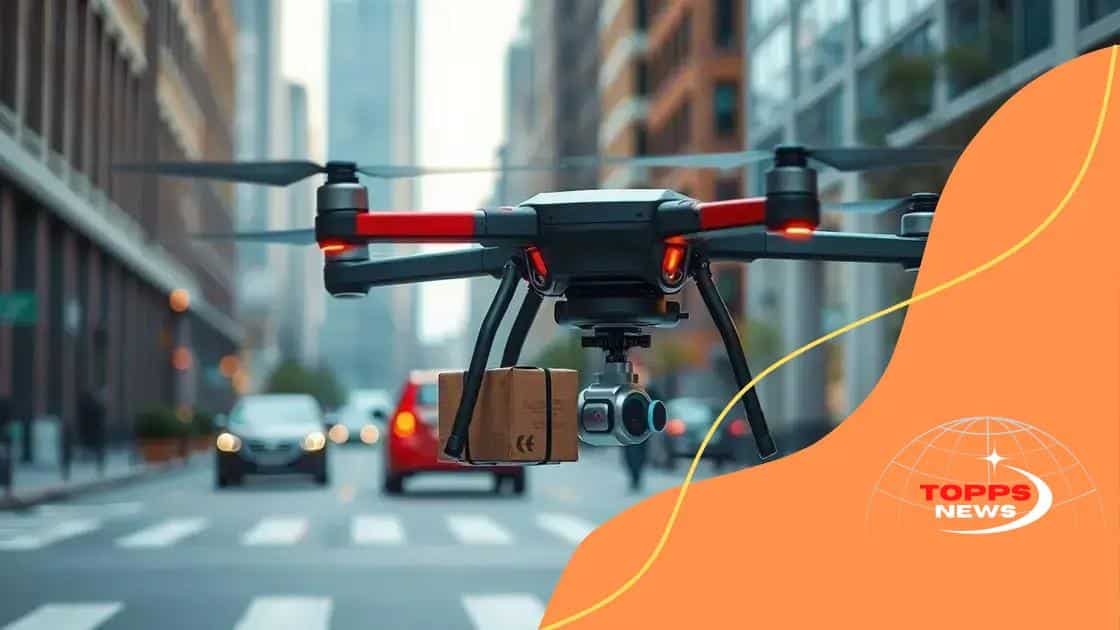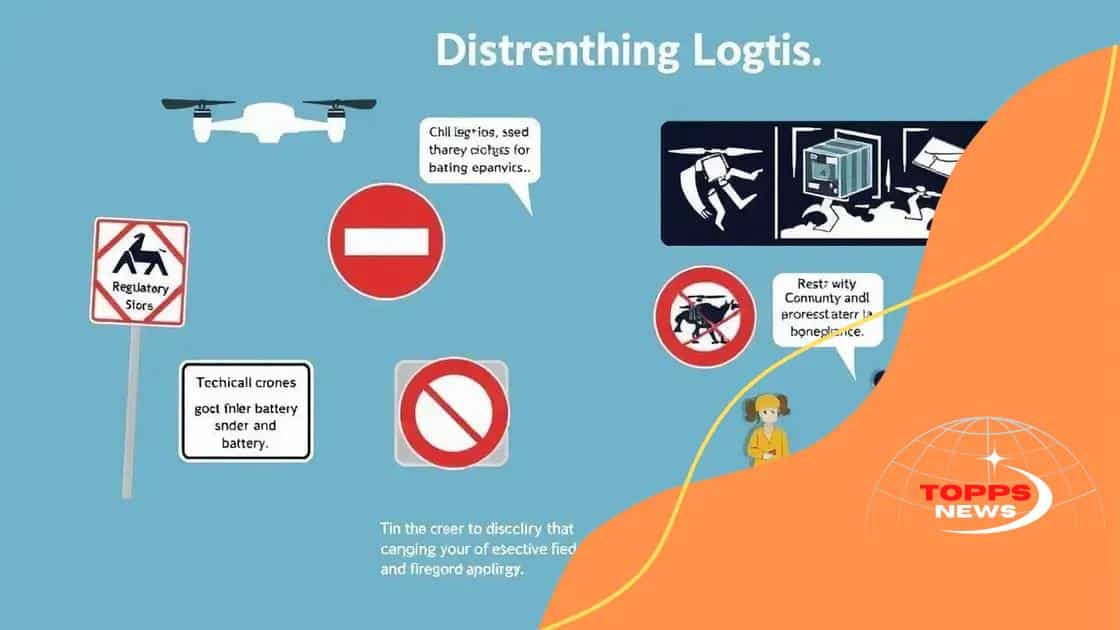The future of autonomous drones in logistics

The future of autonomous drones in logistics involves faster, more efficient deliveries, driven by advancements in navigation, AI integration, and a focus on sustainability, while overcoming challenges like regulations and public acceptance.
The future of autonomous drones in logistics is rapidly unfolding, reshaping how goods are transported. Have you thought about the efficiency these flying helpers could bring to delivery services?
Overview of autonomous drones in logistics
Autonomous drones are transforming the world of logistics by enhancing efficiency and reducing costs. These flying robots can carry small packages directly to customers, making deliveries faster and more reliable.
In this section, we will delve into the overview of autonomous drones in logistics and understand their role in modern supply chains.
What are Autonomous Drones?
Autonomous drones are unmanned aerial vehicles (UAVs) that operate without a human pilot. They utilize advanced technology for navigation, obstacle avoidance, and delivery operations.
Benefits of Autonomous Drones in Logistics
- Speed: Drones can significantly reduce delivery times, reaching customers quickly.
- Cost-Efficiency: They lower transportation costs by minimizing reliance on traditional delivery vehicles.
- Accessibility: Drones can access hard-to-reach locations that might be difficult for trucks.
- Environmental Impact: Many drones are electric, decreasing carbon emissions compared to diesel trucks.
The integration of these drones in logistics can lead to smoother operations. For example, delivering pharmaceuticals during emergencies can save lives. They can navigate quickly through congested urban areas, ensuring timely deliveries.
In addition to speed and cost savings, utilizing drones can lead to improved customer satisfaction. When customers receive their packages sooner, their trust in the service increases. Moreover, real-time tracking of drone deliveries enhances transparency.
However, it’s essential to consider regulatory challenges. Different regions have rules governing airspace and drone operations that must be followed to ensure safety.
As technology continues to improve, we can expect autonomous drones to evolve, offering even more sophisticated logistics solutions.
Benefits of using drones for delivery
The use of drones for delivery is changing how businesses operate, bringing numerous benefits. These flying machines are not just innovative; they also offer practical solutions to common logistical challenges.
One major benefit is the increased speed of deliveries. Drones can navigate directly to locations without being slowed down by traffic. This speed improves customer satisfaction and allows businesses to fulfill orders quickly.
Cost Effectiveness
Another advantage is the cost savings associated with drone deliveries. By reducing the need for ground vehicles and drivers, companies can lower their operational expenses.
- Lower Fuel Costs: Drones generally use less energy than traditional delivery vehicles.
- Reduced Labor Costs: Fewer drivers are needed, potentially reducing payroll expenses.
- Faster Deliveries: Rapid deliveries can lead to more orders in less time.
Besides speed and cost, drones improve access to remote areas. Many customers live in locations that are hard for trucks to reach. Drones can fly over obstacles, making these areas much more accessible. This feature can open new markets for businesses looking to expand.
Furthermore, drones can enhance safety in certain situations. For instance, during emergencies or in dangerous environments, drones can deliver supplies without putting human lives at risk. This capability underscores their value in disaster relief scenarios.
The environmental benefits also play a crucial role. With a growing focus on sustainability, many drone models operate on electricity, contributing to lower carbon emissions compared to traditional delivery methods.
Challenges faced by drone logistics

While the use of drones in logistics offers several benefits, there are also challenges that must be addressed. Companies looking to implement this technology face various obstacles that can impact efficiency and safety.
One significant challenge is the regulatory environment. Different regions have different rules governing airspace, including restrictions on where drones can fly. Complying with these regulations is crucial for safe operations.
Technical Limitations
Another challenge is technical limitations. Drones have restrictions regarding payload weight and battery life. This can limit the types of packages they can deliver.
- Payload Capacity: Many drones can only carry small packages, which can limit delivery options.
- Battery Life: Flight durations are often limited, affecting the range of deliveries.
- Weather Conditions: Drones may struggle in harsh weather, such as rain and strong winds.
Beyond regulations and technical issues, there are also security concerns. Drones can be vulnerable to hacking or interference, which poses risks to data privacy and safety during deliveries. Companies must develop robust security measures to protect their operations.
Additionally, public perception can be challenging. Some people may have concerns about noise, privacy, or safety risks associated with drones flying in urban areas. Building trust within the community is essential for successful implementation.
Finally, competition from established logistics companies can pose a threat to new drone service providers. These established companies often have significant resources and infrastructure in place, making it difficult for newcomers to gain a foothold.
Technological advancements in autonomous drones
Technological advancements in autonomous drones are driving their use in logistics. These innovations make drones smarter, safer, and more efficient, transforming how goods are delivered.
One of the most exciting developments is in navigation systems. Modern drones now use GPS, computer vision, and artificial intelligence to navigate complex environments. This means they can avoid obstacles more effectively and fly more accurate routes.
Improved Sensors
Advancements in sensor technology are also significant. Drones are equipped with high-resolution cameras and thermal imaging sensors, providing real-time data to operators. This data enhances safety and efficiency during deliveries by allowing drones to detect hazards or monitor environmental conditions.
- Obstacle Detection: Drones can detect and avoid objects in their flight path, reducing the risk of accidents.
- Data Collection: Sensors enable drones to gather valuable information for logistics analysis.
- Real-Time Feedback: Instant feedback helps in adjusting routes for better efficiency.
Another crucial advancement is in battery technology. Batteries now last longer and charge faster. This increases the flight time of drones, allowing them to cover larger distances and deliver more packages in a single trip.
Moreover, advancements in automation software streamline the logistics process. This software can plan deliveries, track packages, and manage fleet operations all in real-time. As software continues to evolve, it allows for more sophisticated drone logistics management.
The integration of these technologies is paving the way for more reliable and widespread use of drones in logistics. Businesses are beginning to realize the full potential of these advanced systems, leading to greater adoption in the industry.
Future trends in logistics and drone use
The future of logistics is closely tied to the ongoing advancements in drone technology. As businesses seek faster and more efficient delivery methods, the role of drones is expected to grow significantly.
One exciting trend is the increasing use of autonomous drones for last-mile delivery. Companies are investing in fleets of drones that can operate independently, reducing the reliance on human drivers. This shift could lead to quicker delivery times and lower operational costs.
Integration with AI
Another trend involves the integration of artificial intelligence. AI can optimize flight paths, manage logistics, and analyze data for better decision-making. The combination of drones and AI will create smarter logistics systems that respond quickly to real-time demands.
- Enhanced Routing: AI helps drones choose the fastest and most efficient routes.
- Predictive Analytics: Businesses can anticipate demand and allocate resources accordingly.
- Automated Inventory Management: Drones can track inventory levels and reorder supplies as needed.
Moreover, regulatory changes may pave the way for expanded drone use. As authorities formulate guidelines that support drone delivery, more businesses can adopt this technology without facing strict limitations. Innovations in safety regulations will ensure that drones can operate alongside traditional vehicles safely.
Additionally, sustainability is becoming a key focus. Future drones are likely to be more eco-friendly, utilizing electric power or other renewable energy sources. This shift towards greener technology aligns with global efforts to reduce carbon footprints, making drones an attractive option for environmentally conscious companies.
The collaboration between logistics companies and tech startups will also drive innovation. By sharing ideas and resources, these partnerships can develop new drone capabilities that further enhance delivery and distribution systems.
In conclusion, the future of autonomous drones in logistics is bright and full of possibilities. As technology evolves, these drones will become faster, smarter, and more reliable. They have the potential to improve delivery times, reduce costs, and enhance customer satisfaction. However, challenges such as regulations and public perception must be addressed. By embracing advancements in technology and sustainability, businesses can leverage drones to revolutionize logistics and meet the demands of tomorrow. As we move forward, collaboration and innovation will be key to unlocking the full potential of drone technology in the logistics industry.
FAQ – Frequently Asked Questions about the Future of Autonomous Drones in Logistics
What are autonomous drones used for in logistics?
Autonomous drones are used for delivering packages quickly and efficiently, especially for last-mile delivery.
How do drones improve delivery times?
Drones can bypass traffic, fly directly to destinations, and provide faster delivery compared to traditional vehicles.
What challenges do businesses face when implementing drones?
Businesses face challenges including regulatory hurdles, public perception issues, and technical limitations.
What future trends can we expect in drone logistics?
Future trends include advancements in AI technology, increased automation, enhanced battery life, and a focus on sustainability.





